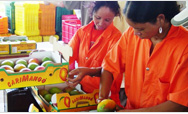 |
|
 |
 |
|
 |
 |
 |
USAID Information:
External Links:
|
|
 |
 |
|
 |
 |
|
Panama


Please note: All linked documents are in PDF format
|
The Development Challenge: Panama's economic and social indicators hide the somber reality of serious under-development in some regions of the country, and security challenges that threaten stability and impede economic development. In 2003, the country's Gross Domestic Product (GDP) totaled $12.2 billion and the annual per capita income was over $3,500, making it one of the middle income countries in Latin America. The literacy rate is 92.5% and life expectancy is relatively high. Although Panama has the highest GDP per capita in Central America, it has the second worst income distribution in Latin America, with about 40% of the population living in poverty. The unemployment rate is 14%, and 30% of the labor force is underemployed. Panama's dual economy consists of a modern and relatively prosperous service sector, including the Panama Canal, banking, flagship registry, and tourism, which accounts for more than 75% of GDP, alongside a traditional, and considerably poorer, rural and agrarian sector.
The transition to democracy in Panama began in 1990 after 20 years of military dictatorship. While there has been significant progress toward a viable democracy, the process is still evolving. Panama's constitution grants strong executive powers to the central government, and gives considerable immunity to legislators, judges, and high-ranking executive branch officials. There are no clear or accessible points of entry for citizens or civil society organizations to influence decision making. Concepts of conflict of interest and transparency are virtually absent from political discourse and practices. Corruption is prevalent and public opinion surveys place corruption as a primary concern, second only to unemployment. In the meantime, press gag laws remain in effect while leadership of the judiciary reform movement falls to a nascent civil society.
Degradation of natural resources, especially water, is taking place at an accelerating and alarming pace. Natural forests lack proper management and protection. The unsustainable and frequently illegal exploitation, trade and use of timber, plants, wildlife, and fisheries are widespread. Poor forest management and inadequate land use practices have a negative impact on biodiversity, soil stability, water quality and quantity, coral reefs, mangroves, and fisheries, all key indicators of a healthy ecosystem. The sustainability of critical watersheds, especially the Panama Canal Watershed, and the environment in general is influenced by governance issues. In Panama, the lack of local empowerment, adequate conservation policies and practices, and deficiencies in the environmental justice system stand in the way of local application and enforcement of environmental regulations. Rural residents have few alternatives for income generation; therefore many follow destructive land use practices and further stimulate urban migration.
Reducing the various constraints to starting a business is a necessary step toward increasing private investment and generating employment. The new administration has set several goals, including "economic development with a human face", and continued bilateral negotiations for a free trade agreement with the United States. The bilateral negotiations leading to a free trade agreement will provide new opportunities for Panama to reduce these constraints and increase and sustain its pace of economic growth.
Fiscal consolidation underpinned by structural reform is essential for keeping public debt under control in Panama. The main challenges are maintaining a sound fiscal policy through compliance with fiscal rules, addressing the urgent need for social security reform, and stepping up the pace of economic growth. While the total public sector debt appears sustainable, there is little room for counter cyclical fiscal policy. External debt in December 2003 was $6.5 billion, with debt servicing absorbing 65% of the Government's budget revenue.
Panama has historic ties and continued relevance to American foreign policy. The country is central to U.S. homeland security, democracy and economic prosperity because of the large volume of commerce moving through the Panama Canal. Panama's position as a regional banking center and proximity to Colombia are other key factors in U.S. national interests that support the country's democratic course and sustainable economic development.
The USAID Program: FY 2005 and FY 2006 funds will be used to implement programs in support of greater government transparency and accountability, increased trade and investment, and improved management of critical watersheds. The Ruling Justly Objective will promote continued progress in transparency and accountability with the participation of civil society in advocacy and oversight of government. The new Economic Freedom Objective will stimulate economic growth by reducing barriers to trade and investment and encouraging market integration. It will also foster sustainable development in the use of natural resources that balances economic development and environmental protection, particularly water to the Panama Canal Watershed (PCW). The Darien Special Objective will also support activities that strengthen selected communities in the Darien region.
Other Program Elements: USAID's Bureau for Latin America and Caribbean funds activities in Panama through its regional programs. The Parks-in-Peril program mitigates threats to conservation and biodiversity in the Amistad Biosphere Reserve. A trade capacity building program is assisting negotiations for a bilateral free trade agreement between Panama and the United States. The Central America Regional Program (G-CAP) implements a range of critical economic and environmental programs in Panama that support priority foreign policy interests in the region, including support for increased participation in global markets; short-term technical assistance to help small producers supply consistent quantities of high-quality Panamanian coffee for domestic and export markets; public/private alliances that promote certification and increased production and sales of environmentally-friendly products; creation of a regional fire and pest prevention and mitigation network; development of a regional remote sensing network to monitor carbon emissions and model impacts on climate for decision making related to climate change vulnerability; and improved environmental management in the Mesoamerican Biological Corridor. G-CAP also improves Panama's capacity to more fully address the HIV/AIDS crisis.
Other Donors: Principal donors in Panama, in addition to the United States, include the Inter-American Development Bank (IDB), the European Union (EU), Spain, Japan, the United Nations Development Program (UNDP), and the United Nations Food and Agriculture Organization (FAO). The largest donor in democracy is the IDB, which supports improvements in the quality of the country's legal and judicial services to strengthen the rule of law and consolidate democracy. Spain, the EU, and the UNDP focus their assistance on the judicial sector and tourism. Japan supports environmental education and training in forestry and agro-forestry techniques. Both Japan and the IDB fund activities promoting the conversion of destructive agricultural practices to environmentally-friendly agricultural production in the PCW. These activities complement USAID's efforts as the major donor in the PCW. Assistance form the FAO supports the Ministry of Agricultural Development in its implementation of land use changes in the rural eastern region of the PCW. USAID is the only donor working in the area of transparency and accountability.
Back to Top ^
|


